First, let me ask you a question. At what age do you think the knee joint begins to deteriorate? 60 years old? 50 years old? 40 years old?
In fact, the time of knee joint degeneration is much earlier than you imagine! Knee joint degeneration originates from cartilage degeneration. With age, obesity, lack of exercise, and other factors, cartilage performance begins to decline, becoming thinner and more brittle. Under adverse external stimuli, it is increasingly prone to damage.
The degeneration of cartilage begins after the age of 20. Simply put, the peak of cartilage performance occurs around the age of 20, after which it will decline. After the age of 35, the bone density of the human body also began to decline. Combined with muscle loss, after the age of 40, the incidence rate of knee degenerative diseases would rise sharply. After the age of 60, it was even more toward the peak. Almost every elderly person would be troubled by osteoarthritis.
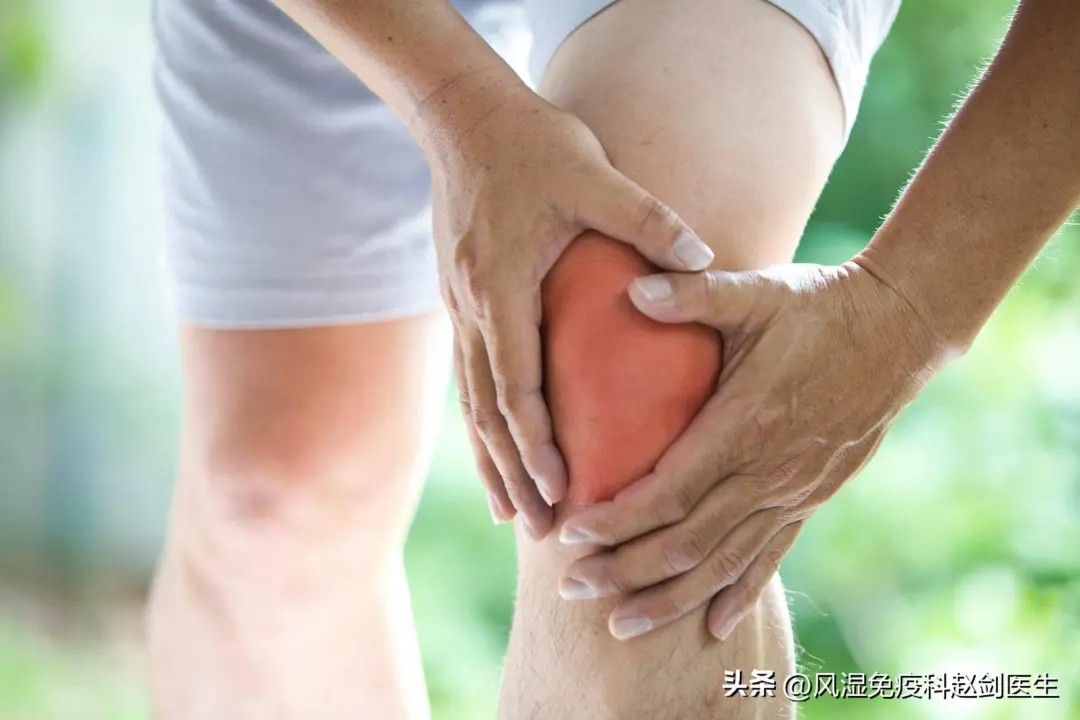
▲ Knee osteoarthritis is more common in middle-aged and elderly people, but cartilage degeneration begins at a young age
Faced with knee joint degeneration, can we only be helpless? In fact, there are many methods to delay knee joint degeneration, and one important one is to improve the nutritional supply of the knee joint. Glucosamine chondroitin calcium tablets play this role!
Aminochondroitin sulfate calcium tablets actually contain three main ingredients: glucosamine, chondroitin sulfate, and calcium. Next, let's take a look at the effects of these three nutrients on preventing knee joint degeneration and how to use them correctly!
What is glucosamine and what is its effect on knee osteoarthritis?
Glucosamine is a natural monosaccharide, an important component of glycosaminoglycans and hyaluronic acid, and a necessary component for synthesizing proteoglycans in cartilage matrix. The degeneration of articular cartilage also has the "function" of loss of glucosamine. Studies have shown that glucosamine begins to be lost and no longer produced around the age of 30. By the age of 45, our glucosamine is only equivalent to 18% of that in adolescence, and in elderly people after the age of 60, there is even less glucosamine left.
When our own glucosamine is insufficient, we will consider exogenous supplementation. A 3-year study found that long-term use of glucosamine can significantly slow down the process of joint space narrowing, thereby delaying the speed of cartilage degeneration.
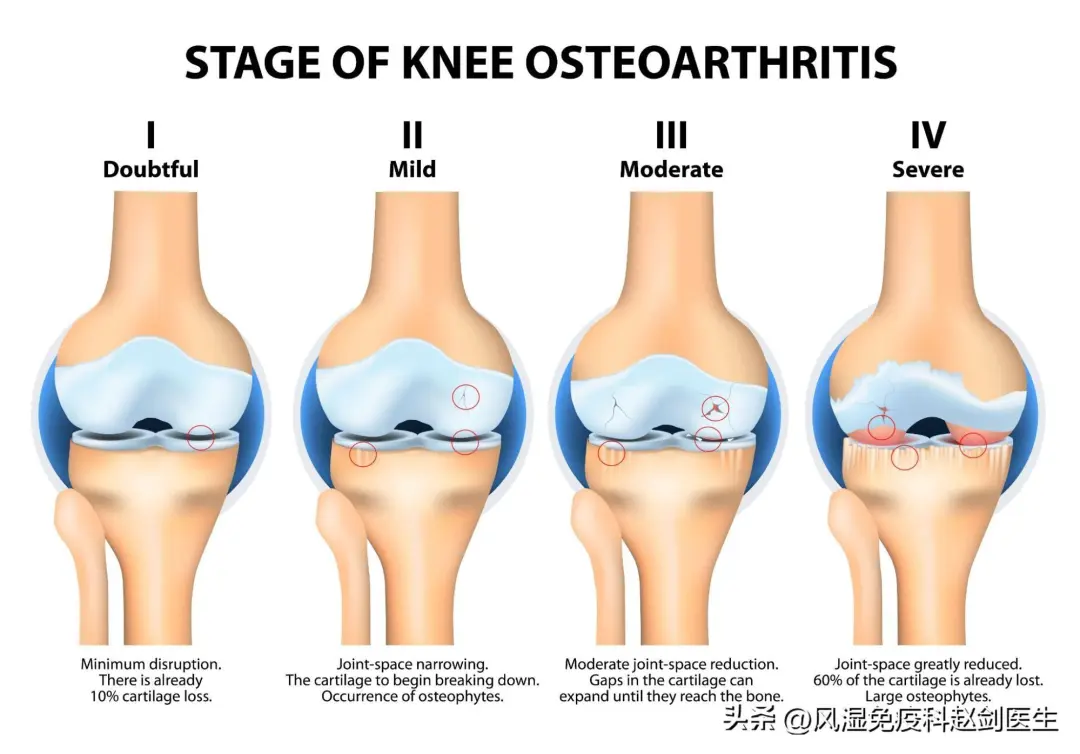
▲ The development process of knee osteoarthritis
Glucosamine is a therapeutic drug for early knee osteoarthritis:
Aminosaccharides have cartilage repair properties - as mentioned earlier, glucosamine is an important component in the synthesis of joint cartilage matrix and joint synovial fluid. Supplementing with glucosamine promotes cartilage metabolism and helps repair and maintain joint structure.
Aminosugars have anti-inflammatory effects - they can reduce the release of inflammatory mediators in joints, thereby reducing pain and swelling. Many people are not aware that glucosamine has anti-inflammatory effects, mainly because its anti-inflammatory effects are weaker compared to nonsteroidal anti-inflammatory drugs.
It should be noted that not all patients with knee osteoarthritis can benefit from glucosamine. Aminosaccharides are suitable for patients with early knee osteoarthritis, and the smaller the damage to the joint cartilage structure, the better the effect of glucosamine can be reflected. It should be noted that once joint cartilage is severely damaged, the weak repair effect produced by glucosamine cannot be repaired. The role of glucosamine is more to delay the degeneration of cartilage and protect it. In addition, for obvious persistent joint pain, the anti-inflammatory effect of glucosamine is limited and may be difficult to alleviate.

▲ Patients with mid to late stage knee osteoarthritis may have ineffective treatment with glucosamine
Therefore, patients with knee osteoarthritis should use glucosamine as early as possible, and it is even recommended that middle-aged people over 40 years old use glucosamine as a nutritional supplement to delay the degeneration of joint cartilage.
Regarding the usage of glucosamine, patients with knee osteoarthritis must ensure sufficient and thorough treatment. It is generally recommended to consume 1500 milligrams of glucosamine per day, which can be taken 2-3 times a day. Continuous use for more than 8 weeks is effective, and use for more than 1 year has a more stable therapeutic effect. If there is no significant reaction after taking glucosamine for 6 months, it is not recommended to continue using it.
What is chondroitin sulfate and its effect on knee osteoarthritis?
The function of chondroitin sulfate, similar to glucosamine, is also one of the main components of articular cartilage. It protects articular cartilage and delays its degeneration through exogenous supplementation.
Chondroitin promotes hydration - Chondroitin is an important component of cartilage matrix with strong water absorption ability. It is precisely because of this water absorption ability that articular cartilage has good elasticity and shock absorption ability, playing a role in protecting joints and supporting movement.
The destructive effect of chondroitin sulfate on enzymes - chondroitin sulfate can also inhibit the activity of enzymes that damage cartilage, such as matrix metalloproteinases, thereby slowing down the process of cartilage degeneration.
However, there is controversy over whether glucosamine or chondroitin sulfate can treat knee osteoarthritis, and the opinions of various academic guidelines are also inconsistent. Based on the high safety and minimal serious side effects of this drug, domestic guidelines still consider it as a treatment option for knee osteoarthritis.
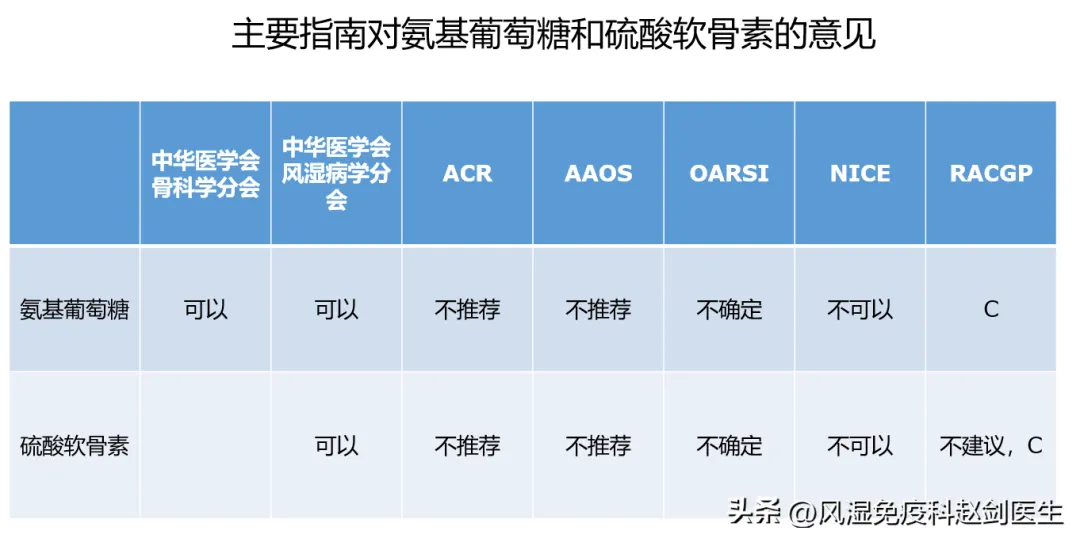
▲Recommendations for glucosamine chondroitin sulfate in the guidelines
The usage of chondroitin sulfate is generally recommended to consume 1200 milligrams per day, which can be taken 2-3 times. There is a viewpoint that chondroitin sulfate should be used in combination with glucosamine to achieve definite clinical efficacy, so there are guidelines recommending the combination of the two.
How does calcium supplementation help prevent knee joint degeneration?
Can calcium supplementation help prevent knee joint degeneration? Many people may not associate the two, but in reality, bone and joint health are inseparable!
Where is the articular cartilage located in the joint? As we chew on pig and sheep hooves, we can see that articular cartilage covers the surface of the bone ends inside the joint. One of its functions is to protect the bone ends and prevent direct friction and collision between bones.
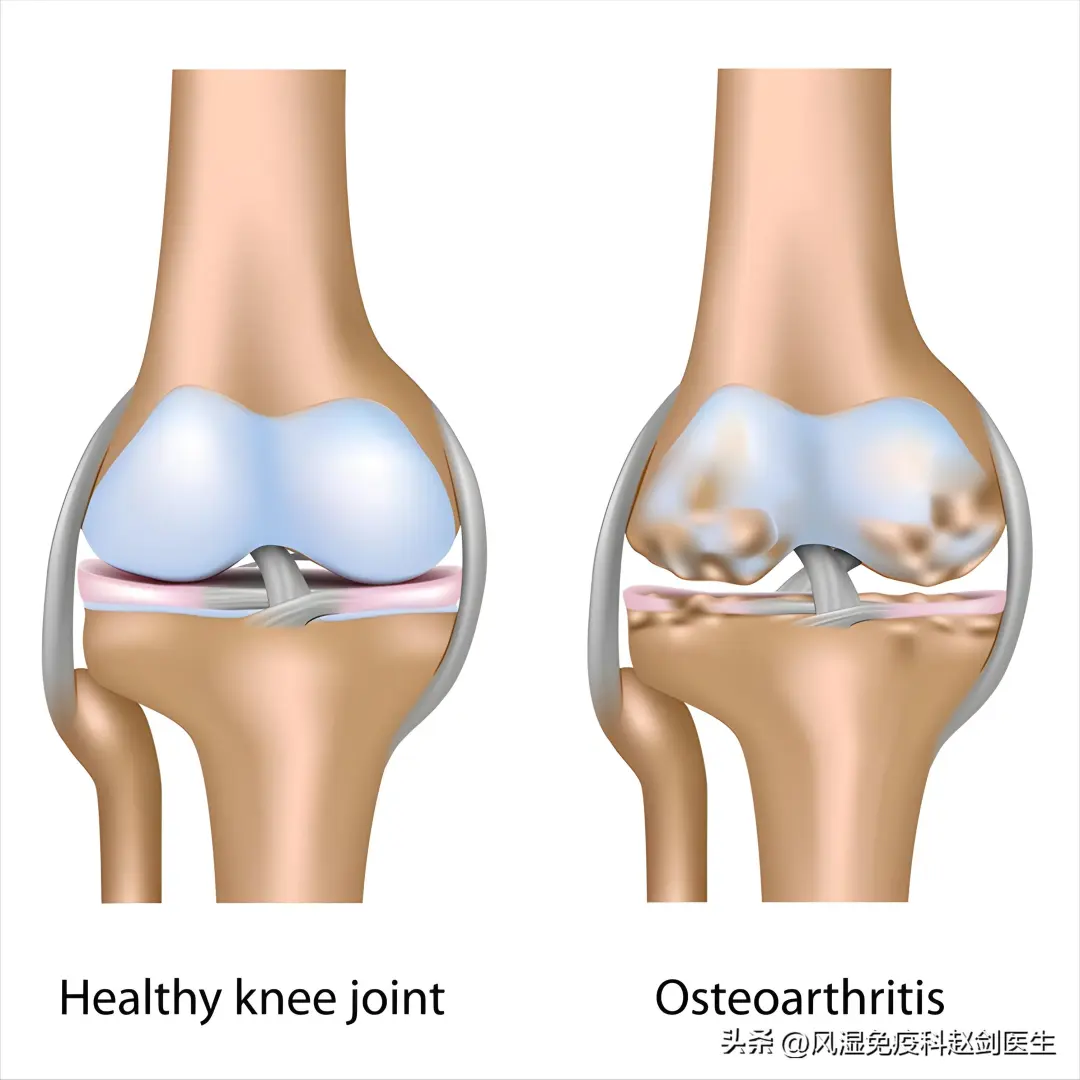
▲ Cartilage plays a role in protecting bone ends and buffering vibrations
Cartilage covers the surface of bone ends. When a joint is subjected to force, the force is buffered by cartilage and ultimately transmitted to the bone, causing both to prosper and suffer. If there is osteoporosis at the joint bone end, the cartilage will collapse like an empty floor, making it more prone to damage. This is a fact that many people do not know. Osteoporosis increases the risk of knee osteoarthritis.
Therefore, for patients with knee osteoarthritis, maintaining bone density also has the effect of delaying cartilage degeneration.
Of course, the method to maintain bone density is definitely not just calcium supplementation, but we should first think of calcium supplementation.
For young people, the absorption capacity of the gastrointestinal tract is good, and their metabolic capacity is good. The best way to supplement calcium is through dietary supplements, such as milk and nuts, which are rich in calcium. While supplementing calcium, it is also necessary to supplement vitamin D. Young people have a strong ability to synthesize vitamin D on their own and can expose themselves to more sunlight to synthesize it.
But for older people, their metabolic capacity may decrease, and they may also suffer from metabolic syndrome. At this time, they may not be able to obtain enough calcium through food and cannot supplement enough vitamin D through sun exposure. Therefore, they still need to supplement with calcium and vitamin D supplements.

▲ Osteoporosis increases the risk of osteoarthritis
If it is a female patient over 50 years old, postmenopausal osteoporosis may be caused by estrogen deficiency. In addition to calcium supplementation and vitamin D, standardized measures such as estrogen replacement therapy should also be taken to treat osteoporosis.
04 Follow the Pyramid Principle for Knee Osteoarthritis
Finally, let's talk about the standardized treatment of knee osteoarthritis.
Knee osteoarthritis is a disease caused by cartilage degeneration, an aging joint disease that belongs to the natural law and cannot be reversed or cured. What we can do is to prevent, detect, and control its development at an early stage.
Firstly, it should be clarified that glucosamine chondroitin calcium tablets are drugs that may have therapeutic effects on knee osteoarthritis. However, they are mainly used as nutritional drugs to improve the condition, with limited effectiveness and slow onset. They are an auxiliary treatment method, and it cannot be expected that taking nutritional drugs will completely prevent joint toxicity!

▲ To correctly understand the function of glucosamine chondroitin calcium tablets
At present, the treatment of knee osteoarthritis follows the pyramid principle, which is to adopt the most suitable treatment plan according to the different stages of disease development. The pyramid is divided into 4 layers:
The first layer is basic treatment - this is a treatment that all knee osteoarthritis must adhere to, and can also be used as a method to prevent knee joint degeneration in middle-aged and elderly people. Including patient education, exercise therapy, physical therapy, and action support. Simply put, it means understanding how joint cartilage degenerates and knowing how to protect it. When you reach middle age, you should act within your means and avoid easily engaging in sports that are prone to injury. You should also pay attention to joint protection in daily life, avoid bad postures such as standing, sitting, and squatting for long periods of time. When engaging in physical labor, you should pay attention to rest and not neglect your body like when you were young. People who lack exercise should start exercising. Lack of exercise can cause significant harm to joints, affecting the nutrient intake of cartilage, accelerating bone and muscle loss, reducing joint stability, and increasing the risk of joint injury.
The second layer is medication treatment - in fact, for early knee arthritis patients, if basic treatment is done when the symptoms are mild, there is hope to prevent the disease from developing and there is no need to use painkillers. In terms of drug therapy, it includes analgesics, intra-articular injection drugs, slow acting drugs that improve the condition, traditional Chinese medicine, etc. Aminochondroitin sulfate calcium tablets are slow acting drugs that can improve the condition and can also be used by early-stage patients. However, based on their characteristics, they are not suitable for patients with severe joint cartilage damage in the middle and late stages. In terms of pain relief, it is recommended to first use external medication, such as nonsteroidal topical drugs or Chinese ointment patches, and not directly take orally. For patients with obvious pain, if external medication is not effective, oral administration should be considered, and the main medication is nonsteroidal anti-inflammatory drugs. Joint cavity injection drugs can both delay the condition and provide pain relief. Sodium hyaluronate and PAP can delay the condition, while closed needles are used for pain relief. Joint injection treatment must be conducted in a formal medical institution and evaluated before use.
The third layer is restorative treatment, including arthroscopic surgery, cartilage repair surgery, force line correction surgery, etc. The most commonly used method is arthroscopy, and there are also needle knife endoscopes that combine traditional Chinese and Western medicine. They use minimally invasive methods to clean free bodies or repair cartilage in the joint cavity, which can improve symptoms and alleviate the condition.
The fourth layer is reconstruction treatment - this is aimed at extremely severe late stage patients, whose joint cartilage is severely broken, joint structure is severely damaged, joints lose their ability to move, cannot stand up, and can only be bedridden or rely on wheelchairs. At this time, the only way to restore the patient's ability to move is to replace artificial joints.
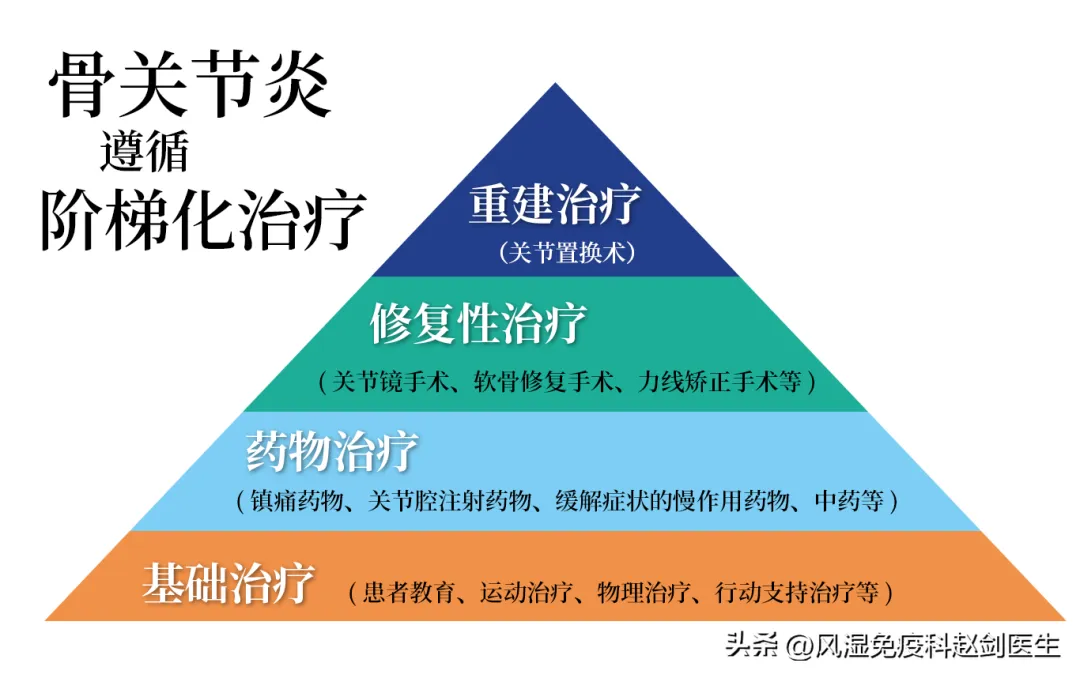
▲The principle of step-by-step treatment for knee osteoarthritis